Common eider
Somateria mollissima
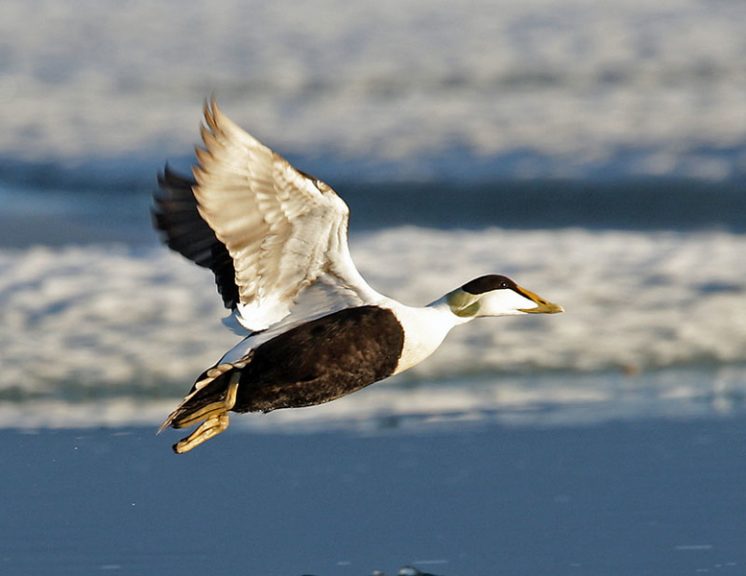
Common Eider male. Photo: Carsten Egevang.
The eider is a sea duck that is associated with the coastal marine environment. Wing span: 95-105 cm, length: 60-70 cm. Male: White back and chest. Black cap, bug and fly feather. Green in the neck. Young male: Black with white parts. She and young bird: Brownish with dark padding. Duckling: Brown.
Food
Mostly mussels, but also other benthic animals such as crabs and worms.
Breeding time
Females of common eider usually breed for the first time as 3-year-olds. In some areas they find a male already in the autumn or winter, while in other places they only find a mate in the spring. The pair stays together until the female is well on her way to incubating.
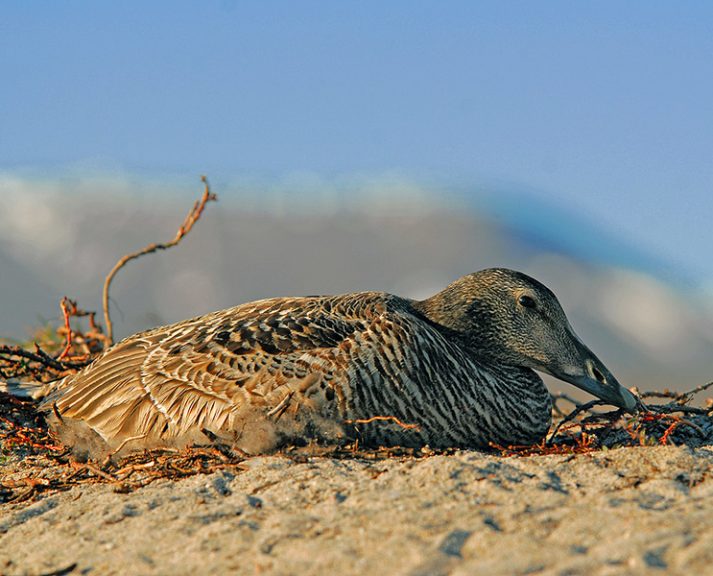
Common Eider female on the nest. Photo: Lars Maltha Rasmussen.
The eider birds usually arrive at the breeding grounds during May, depending on the location and weather conditions. The females often return to their place of birth, and they like to breed close to the old nesting place. Eiders typically breed on islets and islets, where they are protected from foxes. They typically breed in dense colonies, which can range in size from a few pairs to several thousand pairs. When the female goes ashore to select a nesting site, the male usually follows closely. The nest is a depression in the ground. It is lined with large amounts of down, which is picked from the female’s breast when the first eggs are laid. In some cases, the female recycles an old nesting bowl. Otherwise the female must make a new nest. She does this by kicking soil away while turning around herself.
The female usually lays 3-4 eggs. She usually lays one egg a day, but only begins to incubate more constantly after laying the second or third egg. The female incubates for 24-26 days, during which time she leaves the nest only for short periods to drink. Since the female does not consume food during the incubation period, she can lose up to 45% of her weight.
The eggs hatch at the same time, usually within 24 hours. When the ducklings have become dry after approx. 1 day, the female leads them down to the water. Often several litters are collected that are guarded by many females, also by non-breeding females (aunts). As more females arrive with their ducklings, they form larger family flocks with up to 150 ducklings and 10 females. However, the large flocks may well split up again. The ducklings become independent of the female within 55-60 days and ready to fly after 65-75 days.
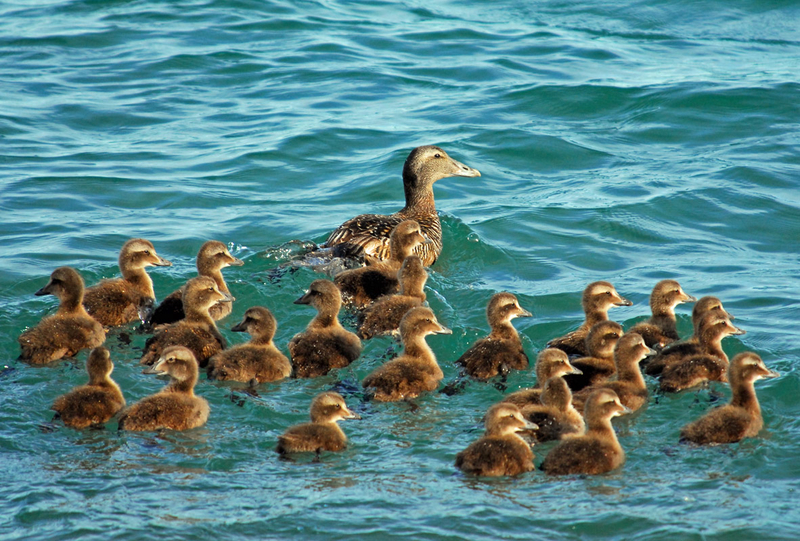
Common Eider female guiding young. Photo: Lars Maltha Rasmussen.
Breeding distribution
Common eider breeds scattered throughout West Greenland, with the largest concentrations in Northwest Greenland. The eider also breeds in Northeast Greenland and Southeast Greenland, although less numerous. Several breeds are described. In Greenland, the breed borealis occurs, which is also widespread in eastern Canada, Iceland, Svalbard and Franz Josef Land. It breeds in areas where ice does not block the coasts and usually on small islands to which foxes do not have access.
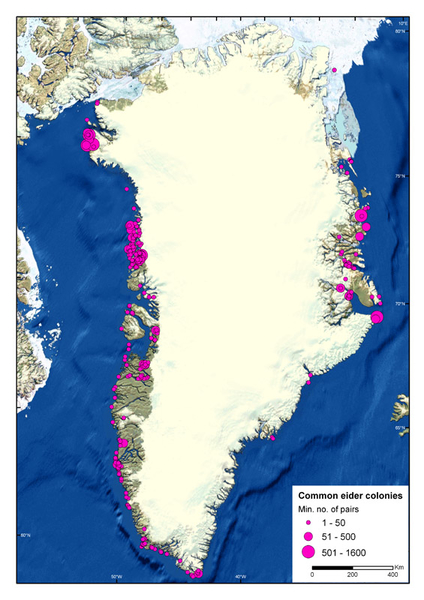
Map showing the distribution of Common Eider in Greenland, with maximum sizes of colonies. Data: GINR and NERI.
Winter distribution and migration
The common eider is predominantly a resident bird in Greenland and only travels fairly short distances as the ice settles. The entire West Greenland breeding population of common eider is believed to trap and overwinter in West Greenland’s open water area. The northernmost breeding populations are assumed to overwinter in the northern part of the open water area. However, the majority of the eider birds that overwinter in southwest Greenland come from Canadian breeding areas. On the map below, red arrows show the migratory routes from the breeding areas within the dotted lines to the wintering areas in the yellow areas. From mid-April, the breeding birds begin to retreat towards the breeding areas. A number of non-breeding birds stay in West Greenland all summer.
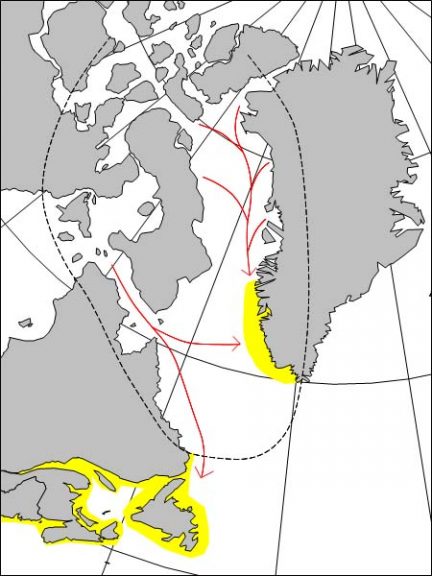
Eder distribution and migratory routes in Greenland and Canada. The eider breeds along coastal stretches within the dotted line. Source: GINR.
The total number of common eider birds that overwinter in West Greenland’s open water area in 1999 and 2017 was estimated at approx. 500,000 birds, while approx. 150,000 overwinter at Newfoundland and Quebec. The northeastern Greenlandic eider ducks migrate away from Greenland to overwinter in the waters around Iceland. However, birds that overwinter around Tasiilaq are probably also from this population. It is also possible that some of the breeding birds from Southeast Greenland overwinter in Southwest Greenland.
File status
The breeding population in West Greenland fell drastically through the 20th century as a consequence of overexploitation. At the end of the 1990s, the total breeding population in West Greenland was estimated at approx. 15,000 breeding pairs. However, a sharp reduction in catches after 2001 reversed the stock development quite quickly and the stock has doubled several times since. The total breeding population in West Greenland was not known exactly today, but in many of the important breeding areas in Northwest Greenland, the population has grown by 10-15% per year over a number of years. In the first years after the sharp reduction in catches in Greenland, the breeding population also began to grow significantly on the Canadian side, until in 2006 bird cholera broke out in several places in Canada.
The total winter population in Southwest Greenland, which consists of Canadian and Greenlandic birds, has only been counted twice, in 1999 and 2017. In both cases, the winter population was estimated at almost 500,000 birds. Seen in the light of the positive development for the breeding population in West Greenland during this period, it is surprising that the winter population has apparently not grown during the same period.
Catch and management
Eider the most frequent catch object in Greenland and hunting pressure has previously been a significant population regulating factor for the breeding population in Greenland and to some extent also for the breeding population in Canada. According to hunting statistics Piniarneq, in the 1990s about 70,000 – 80,000 eider ducks were shot per year in Greenland. As a consequence of a sharp decline in population in Greenland during the last half of the 20th century, the hunting season was shortened quite significantly in 2001. Since then, the hunting yield has been around 20,000 – 30,000 birds per year. This regulation led to a large increase in stocks in West Greenland and the fishing seasons have since been extended a bit again.
Studies suggest that there is some under-reporting to Piniarneq, so the catch figures are probably not completely accurate and must therefore be considered as index figures. On the other hand, some of the slaughtered king eider birds are reported as normal. eider. A study of the distribution of the two species on the board in Nuuk (late 90s) showed that approx. 30% of the eider ducks were king eider ducks, while the proportion reported to Piniarneq was only approx. 5%.
Catching of eider birds is managed through the Government’s executive order on protection and capture of birds, which is prepared by the Ministry of Fisheries, Hunting and Agriculture (Link to executive order in danish).
Read articles about eider ducks:
- Seabirds hit the ships
- Read special issue from PITU about eider here

